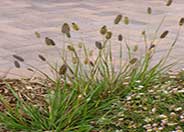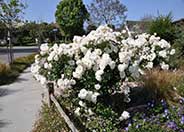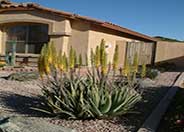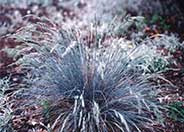
Common name:Dusty Miller, Silver Groundsel
Botanical name:Senecio cineraria
The Dusty Miller exhibits growth to 1' or more, with velvet gray leaves that have broad, roundish lobes. Yellow flower heads appear through the middle of the plant during most months of the year. Cut heads back occasionally to encourage bushiness.

Common name:Spanish Lavender
Botanical name:Lavandula stoechas
This dense shrub grows 2'-3' tall with blue gray foliage and deep purple flowers that have large showy bracts near the top of the spikes. It is drought tolerant .

Common name:Dome Euphorbia
Botanical name:Euphorbia characias
This perennial will reach about 4' tall and has blue green leaves with bright green flowers that bloom from late winter to early spring.

Common name:Red Paintbrush Grass
Botanical name:Pennisetum messiacum
This clumping Pennisetum is most effectively used in mass plantings where the dark, almost black flowers can wave in the wind. Although originally thought to be an evergreen, it goes semi-dormant in most climates in Southern CA. It requires moderate water through the summer. It grows to 2' tall and 2' wide. It should be cut back annually to promote fresh growth. It should not be planted near natural areas.

Common name:Iceberg Floribunda Rose
Botanical name:Rosa 'Iceberg'
This is a shrub rose (there are climbing varieties) with an abundance of fragrant, medium sized, white blooms. It is one of the most popular roses and very tough.

Common name:Aloe Vera or Medicinal Aloe
Botanical name:Aloe vera
The rosette of this plant consists of fleshy gray green leaves, which are narrow, succulent and erect with soft spines on margins. This Aloe is a slow to moderate grower. Flowers are spikes of yellow, 2'-3' tall and bloom late winter to summer. This aloe can form large clumps. It will tolerate full to partial sun, needs some supplemental water in heat and good drainage. It attracts hummingbirds. This aloe is a Mediterranean native. The sap is used for burns and abrasions.

Common name:Western Redbud
Botanical name:Cercis occidentalis
This deciduous shrub or small tree ranges from 6'-10' tall and wide. It is desirable for its magenta spring flowers, yellow to red fall color, and dangling winter seed pods. It is tolerant of many soil types, drought and oak root fungus. It attracts hummingbirds and butterflies. The Western Redbud can be found statewide in CA in the foothills below 4500' elevations in chaparral and woodland communities.
Maintenance Tips
Cercis occidentalis is a very popular California native deciduous tree. The natural form of this plant is that of a multi-branching shrub; however, it is often shaped to be a single trunk so it can be used in many garden spaces. The best way to keep the maintenance low with this tree is to plant it in a sunny location that has well-drained soil and give it the room it needs to reach its mature size. It is fairly pest and disease-resistant and performs very well as a specimen tree in native gardens. The pruning recommendations will depend on the shape of the specimen. If the tree has the multi-trunk, shrub form, the mature height can be 6-10' tall and wide and will naturally grow into a round, compact form. These forms benefit greatly from the thinning method, removing cross-branching or the longer branches to manage the plant's size. The cuts should be made towards the center of the plant, allowing sunlight into the interior. The single trunk form should be pruned the same way, but it will mature much larger and eventually should be pruned by a licensed arborist. Both forms will lose their leaves in the winter, so this is usually the easiest time to prune since the foliage is out of the way.
Common name:Superba Fescue
Botanical name:Festuca amethystina 'Superba'
The Rainbow Fescue is a hardy fescue with fine, blue green foliage that grows 8" tall. It has spring flowers that are 12" above the foliage. This fescue is a very showy, neat grass for sunny spots during spring and fall. The Rainbow Fescue is drought tolerant. -Cornflower Farms

Common name:Hybrid Tea Rose (selections)
Botanical name:Rosa Hybrid Tea varieties
These shrubs and vines are the most loved in the Western USA and are very resilient. They come in a wide variety of sizes and colors and are easy to maintain with proper care. They can be used in a water-conserving garden with careful attention to irrigation practices.
Photographer: GardenSoft